Time-Averaged Turbulent Velocity Flow Field through the Various Bridge Contractions during Large Flooding
Abstract
:1. Introduction
2. Methodology
2.1. Experimental Setup
- (a)
- Width of bridge deck 12.2 m, in accordance with standard two-lane roads;
- (b)
- Bridge barrier 0.61 m high with 0.46 m top without sidewalks on non-bicycle routes;
- (c)
- Slab depth of 0.46 m including the pavement;
- (d)
- Girders 0.43 m wide and 0.46 m deep with 2.74 m spacing.
2.2. Experimental Procedure
3. Results and Discussion
3.1. Classification of Abutment Scour
- Condition A (W/yf1 > 6, La/Bf = 0.53 and 0.77): In a long setback abutment, scour occurs in the floodplain only, well removed from the main channel;
- Condition B (W/yf1 = 0, La/Bf = 1.0): For a bankline abutment, maximum scour occurs in the main channel of a compound channel;
- Condition C (W/yf1 < 6, La/Bf = 0.88): In a short setback abutment, scour occurs on the floodplain in the initial stage, but maximum scour at equilibrium occurs in the main channel because the setback distance is short.
3.2. Velocity Flow Field around the Abutment
4. Conclusions
Author Contributions
Funding
Acknowledgments
Conflicts of Interest
References
- Ettema, R.; Nakato, T.; Muste, M. Estimation of Scour Depth at Bridge Abutments; Final Report, NCHRP 24-20; TRB: Washington, DC, USA, 2010. [Google Scholar]
- Hong, S.H.; Sturm, T.W.; Stoesser, T. Clear water abutment scour in a compound channel for extreme hydrologic events. J. Hydraul. Eng. 2015, 141, 04015005. [Google Scholar] [CrossRef]
- Kwan, T.F.; Melville, B.W. Local scour and flow measurements at bridge abutments. J. Hydraul. Res. 1994, 32, 661–673. [Google Scholar] [CrossRef]
- Melville, B.W.; Coleman, S.E. Bridge Scour; Water Resources Publications: Highlands Ranch, CO, USA, 2000. [Google Scholar]
- Chrisohoides, A.; Sotiropoulos, F.; Sturm, T.W. Coherent structures in flat-bed abutment flow: Computational fluid dynamics simulations and experiments. J. Hydraul. Eng. 2003, 129, 177–186. [Google Scholar] [CrossRef]
- Kim, H.; Roh, M.; Nabi, M. Computational modeling of flow and scour around two cylinders in staggered array. Water 2017, 9, 654. [Google Scholar] [CrossRef]
- Zang, L.; Wang, P.; Yang, W.; Zuo, W.; Gu, X.; Yang, X. Geometric characteristics of spur dike scour under clear-water scour conditions. Water 2018, 10, 680. [Google Scholar] [CrossRef]
- Chen, S.; Tfwala, S.; Wu, T.; Chan, H.; Chou, H. A hooked-collar for bridge piers protection: Flow fields and scour. Water 2018, 10, 1254. [Google Scholar] [CrossRef]
- Zang, L.; Wang, H.; Zang, X.; Wang, B.; Chen, J. The 3-D morphology evolution of spur dike scour under clear-water scour conditions. Water 2018, 10, 1583. [Google Scholar] [CrossRef]
- Yang, Y.; Qi, M.; Li, J.; Ma, X. Evolution of hydrodynamics characteristics with scour hole developing around a pile group. Water 2018, 10, 1632. [Google Scholar] [CrossRef]
- Hong, S.H.; Sturm, T.W. Physical Model Study of Bridge Abutment and Contraction Scour under Submerged Orifice Flow Conditions. In Proceedings of the 33rd IAHR Congress: Water Engineering for a Sustainable Environment, Vancouver, BC, Canada, 9–14 August 2009. [Google Scholar]
- Hong, S.H.; Sturm, T.W. Physical Modeling of Abutment Scour for Overtopping, Submerged Orifice and Free Surface Flows. In Scour and Erosion, Proceedings of the Fifth International Conference on Scour and Erosion, San Francisco, CA, USA, 7–10 November 2010; American Society of Civil Engineers: Reston, VA, USA, 2010. [Google Scholar]
- Saha, R.; Lee, S.; Hong, S.H. A comprehensive method of calculating maximum bridge scour depth. Water 2018, 10, 1572. [Google Scholar] [CrossRef]
- Hong, S.H. Prediction of Clear Water Abutment Scour Depth in Compound Channel for Extreme Hydrologic Events. Ph.D. Thesis, School of Civil and Environmental Engineering, Georgia Institute of Technology, Atlanta, GA, USA, 2013. [Google Scholar]
- Ge, L.; Lee, S.; Sotiropoulos, F.; Sturm, T.W. 3D unsteady RANS modeling of complex hydraulic engineering flows. Part II: Model validation and flow physics. J. Hydraul. Eng. 2005, 131, 809–820. [Google Scholar] [CrossRef]
- Garcia, C.M.; Cantero, M.I.; Nino, Y.; Garcia, M.H. Closure to “Turbulence measurements with acoustic doppler velocimeters”. J. Hydraul. Eng. 2007, 131, 1062–1073. [Google Scholar] [CrossRef]
- Hong, S.H.; Abid, I. Physical model study of bridge contraction scour. KSCE J. Civ. Eng. 2016, 20, 2578–2585. [Google Scholar] [CrossRef]
- Hong, S.H.; Lee, S.O. Insight of Bridge Scour during Extreme Hydrologic Events by Laboratory Model Studies. KSCE J. Civ. Eng. 2018, 22, 12871–12879. [Google Scholar] [CrossRef]
- Lee, S.O.; Hong, S.H. Reproducing field measurements using scaled-down hydraulic model studies in a laboratory. Adv. Civ. Eng. 2018, 2018, 9091506. [Google Scholar] [CrossRef]
- Goring, D.; Nikora, V. Despiking acoustic Doppler velocimeter data. J. Hydraul. Eng. 2002, 128, 117–126. [Google Scholar] [CrossRef]
- Chang, F.; Davis, S. Maryland SHA Procedure for Estimating Scour at Bridge Abutments, Part 2—Clear Water Scour. In Proceedings of Water Resources Engineering ′98; ASCE: Memphis, TN, USA, 1998; pp. 169–173. [Google Scholar]
- Chang, F.; Davis, S. Maryland SHA Procedure for Estimating Scour at Bridge Waterways, Part 1—Live Bed Scour. In Stream Stability and Scour at Highway Bridges; Richardson, E., Lagasse, P., Eds.; American Society of Civil Engineers: Reston, VA, USA, 1999; pp. 4001–4011. [Google Scholar]
- Hong, S.H.; Abid, I. Scour around an erodible abutment with riprap apron over time. J. Hydraul. Eng. 2019, in press. [Google Scholar]
- Kara, S.; Stoesser, T.; Sturm, T.W. Flow dynamics through a submerged bridge opening with overtopping. J. Hydraul. Res. 2015, 53, 186–195. [Google Scholar] [CrossRef]
- Zabilansky, L.J.; Hains, D.B.; Remus, J.I. Increased Bed Erosion Due to Ice. In Cold Regions Engineering 2006: Current Practices in Cold Regions Engineering; American Society for Civil Engineers: Reston, VA, USA, 2006; pp. 1–12. [Google Scholar]
- Hains, D.; Zabilansky, L. Laboratory Test of Scour under Ice: Data and Preliminary Results; ERDC/CRREL TR-04-9; U.S. Army Engineer Research and Development Center: Hanover, NH, USA, 2004. [Google Scholar]
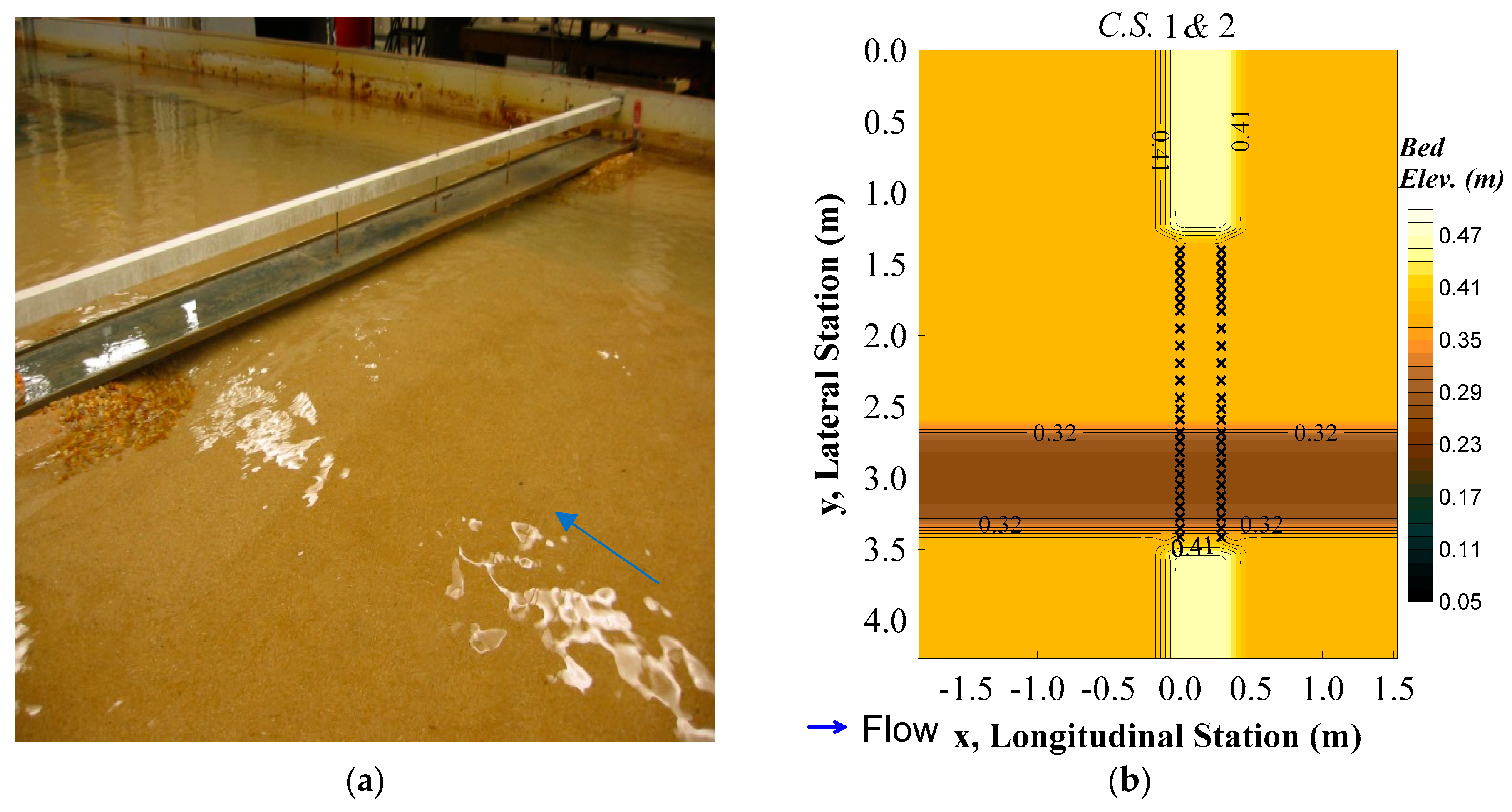
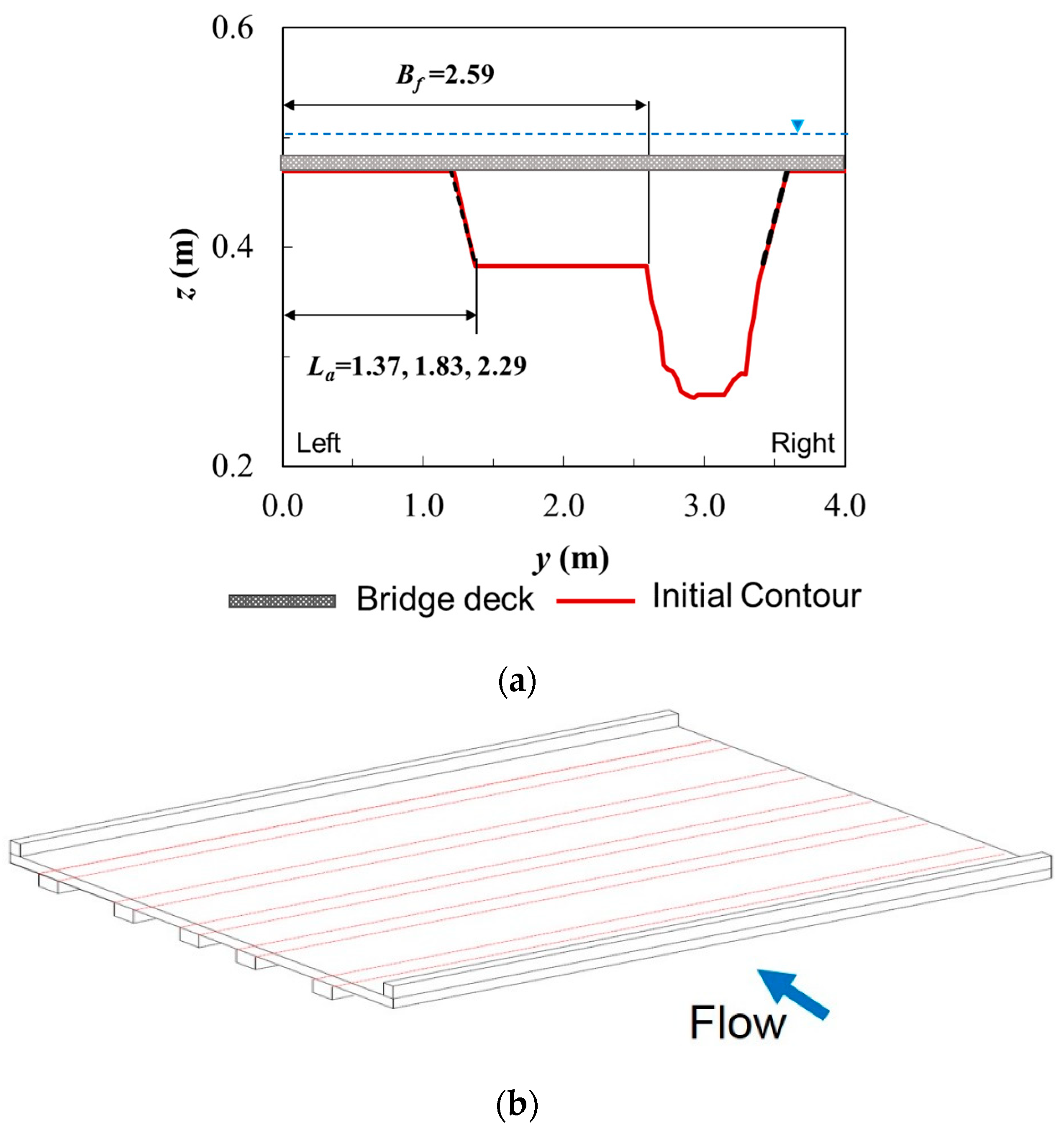
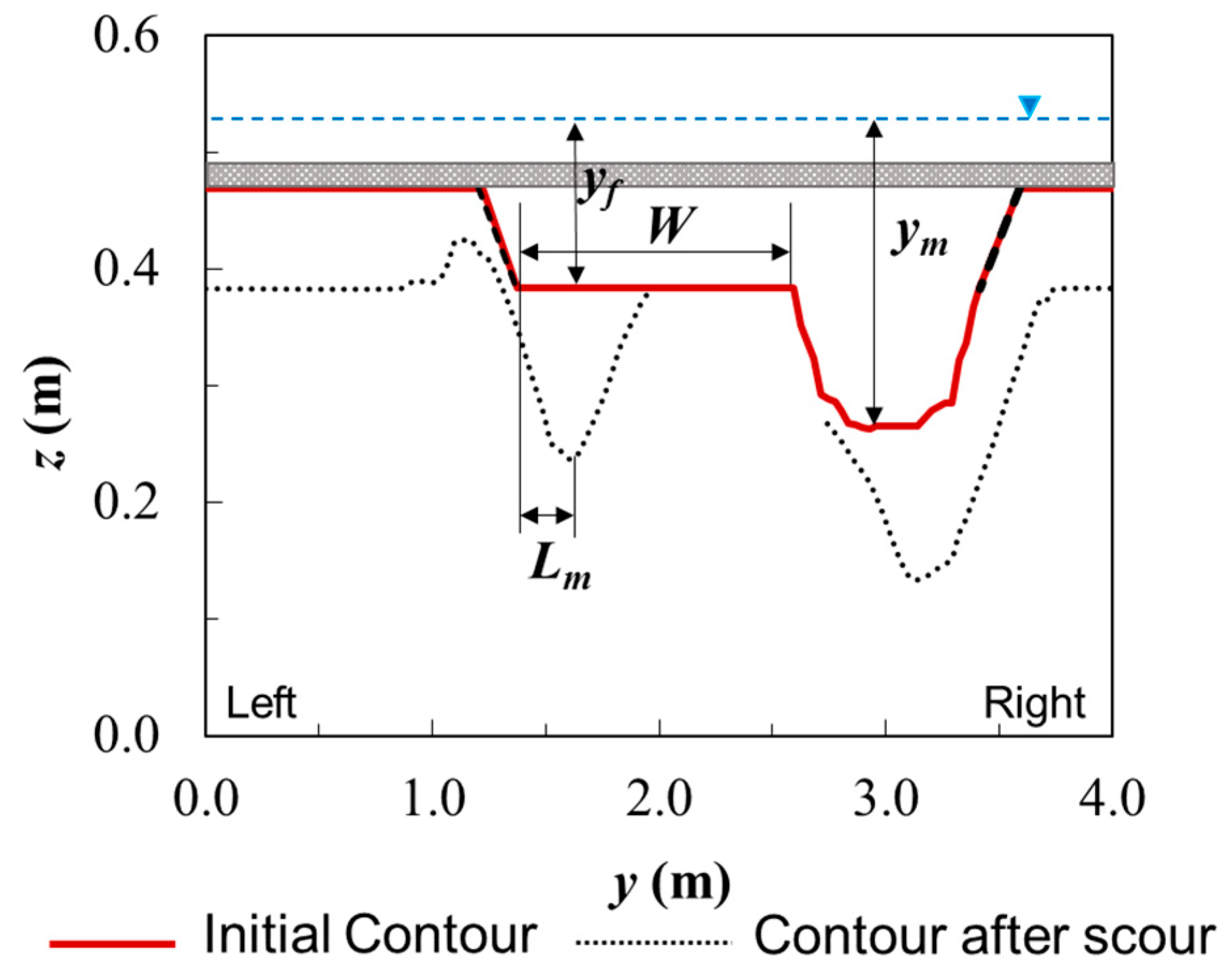
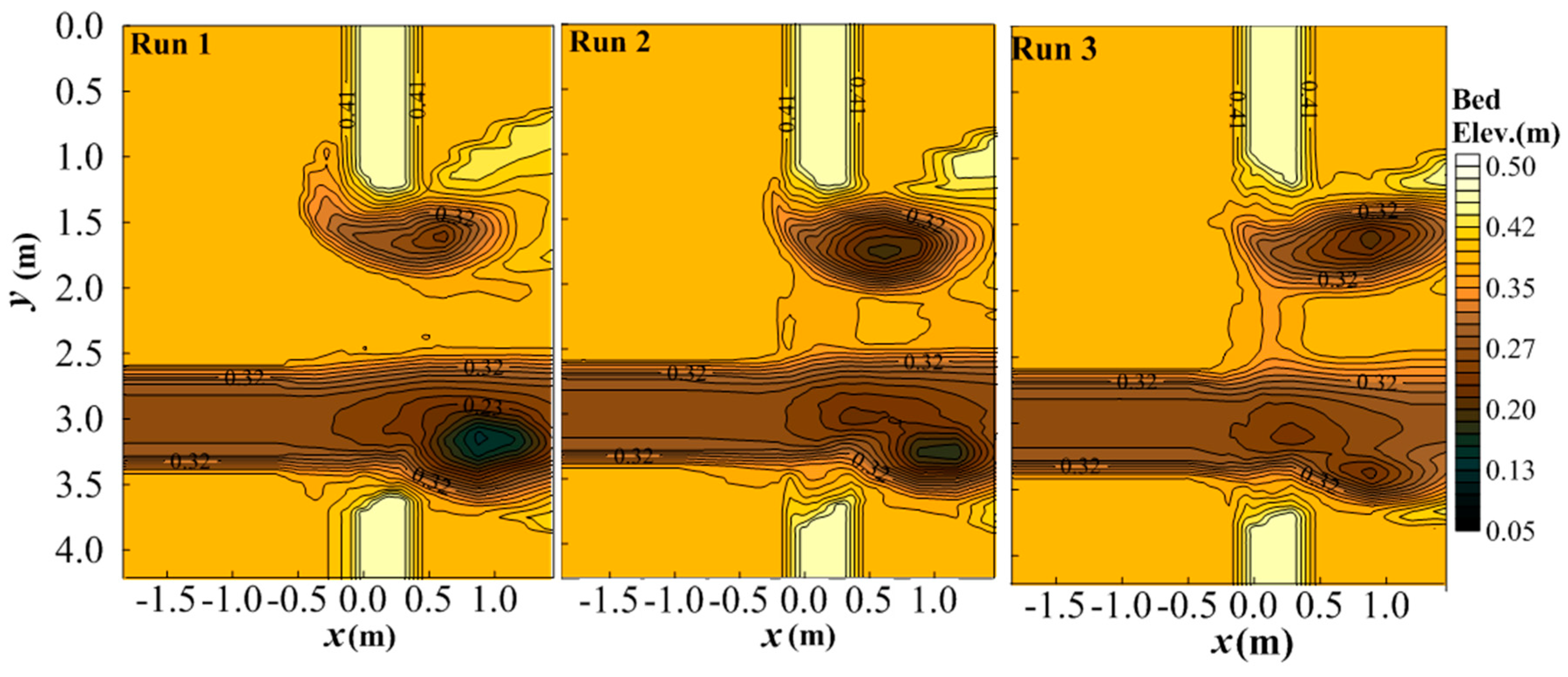
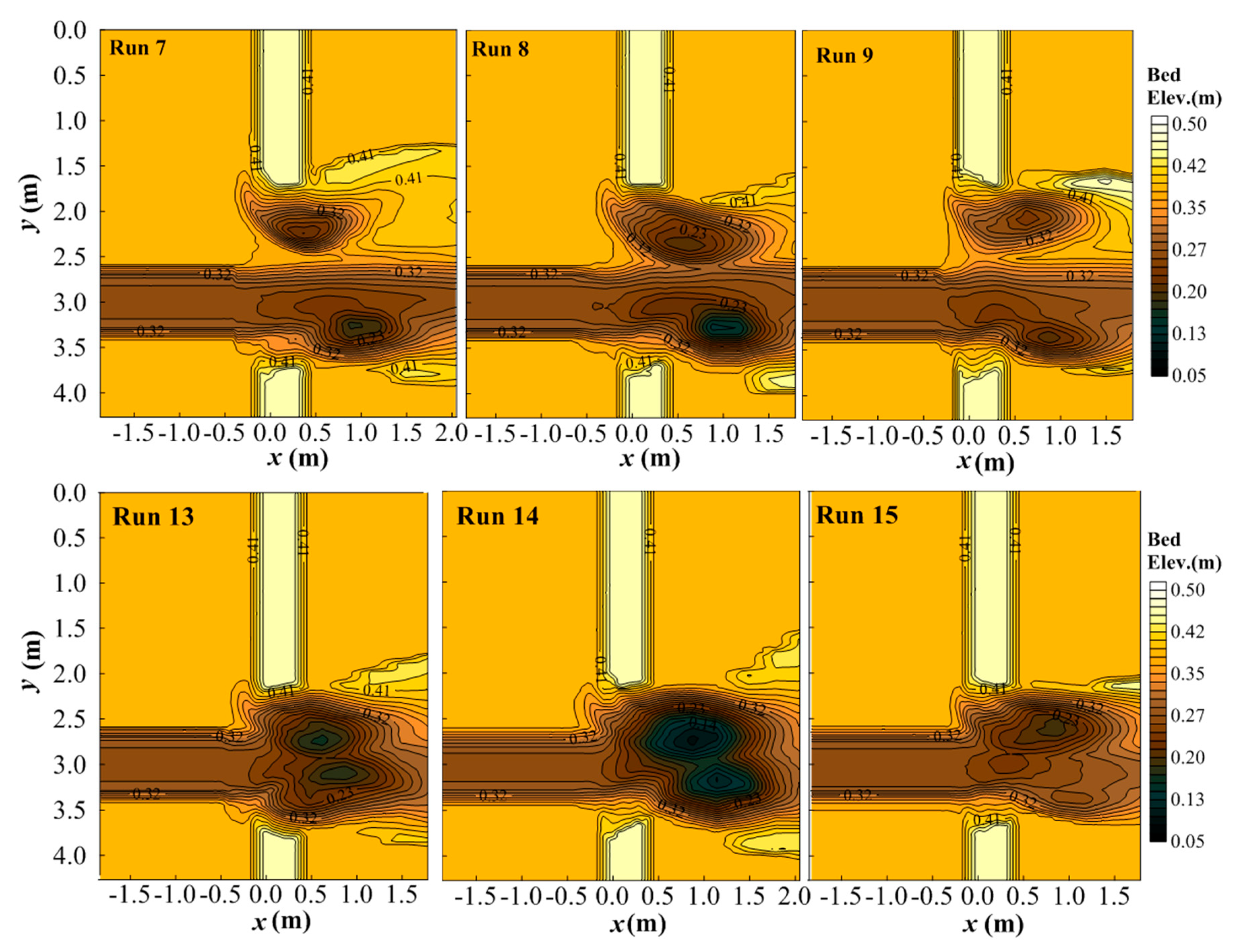
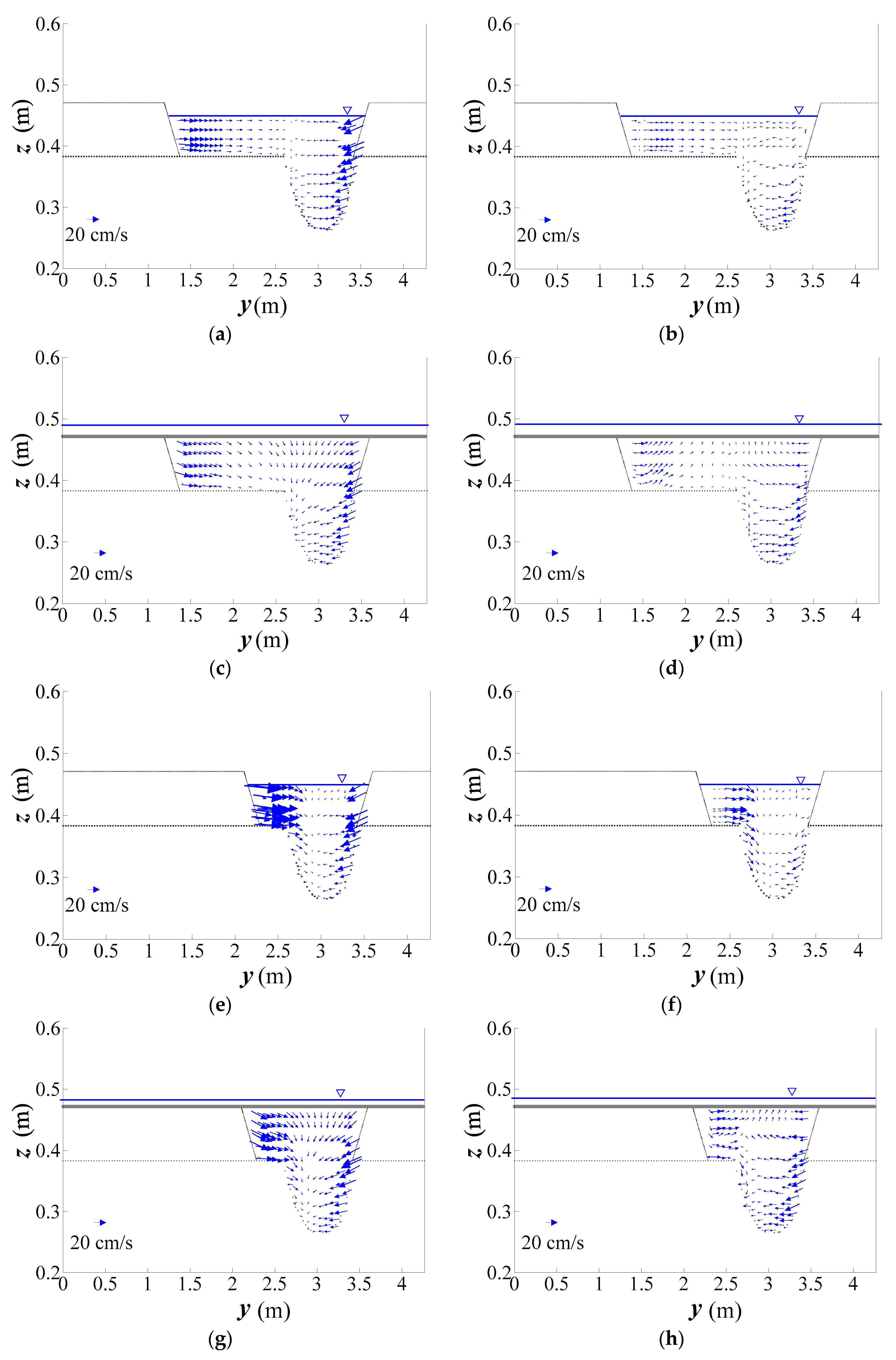
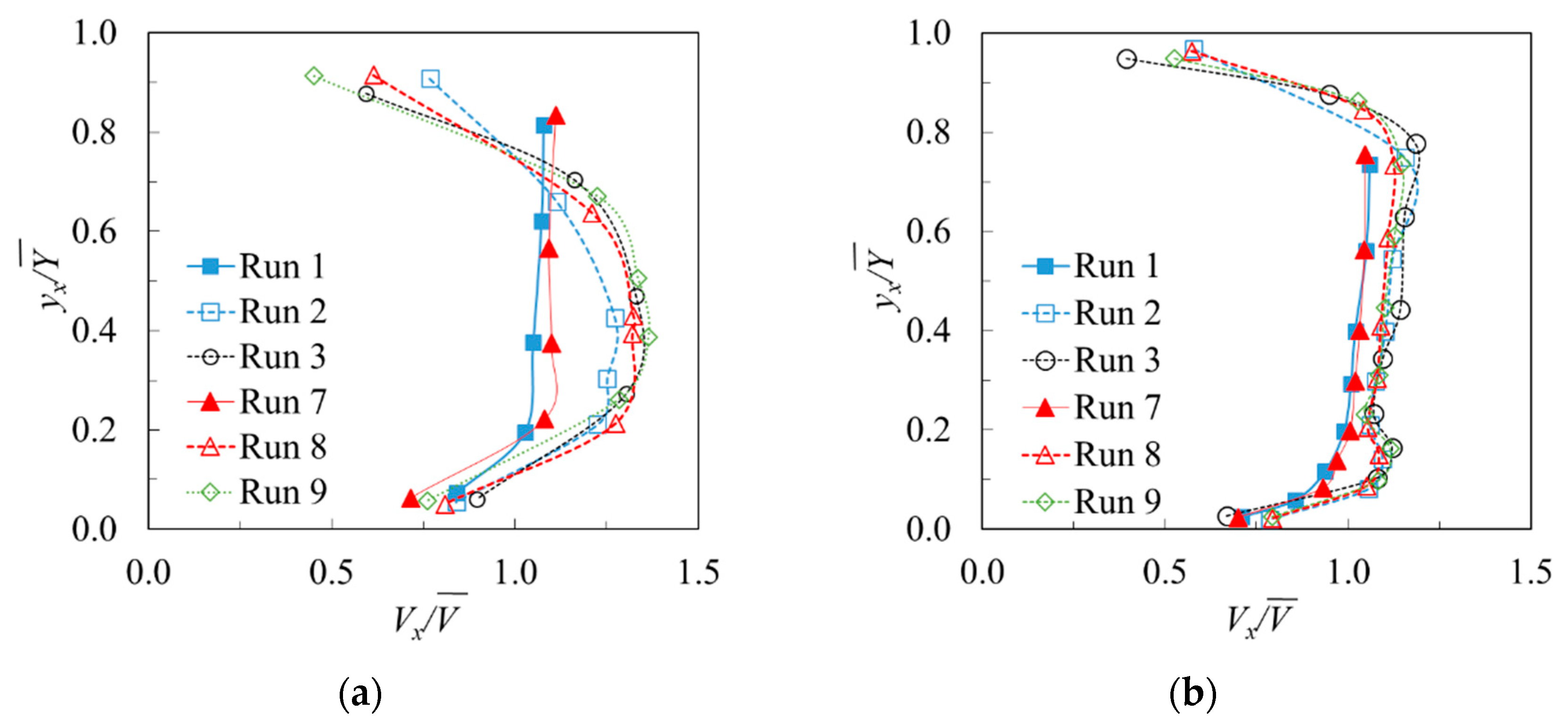
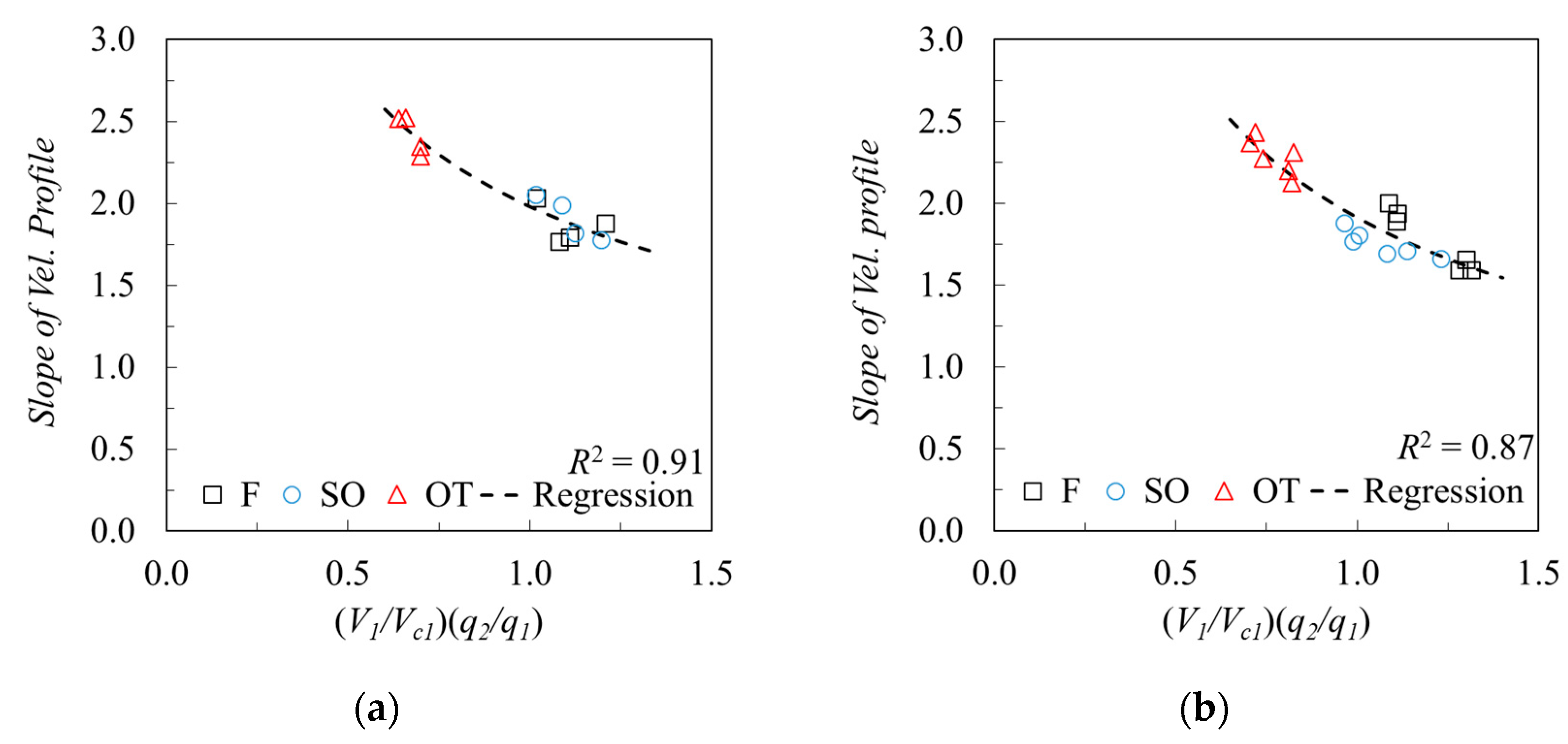
| Run | Flow Type | Q (m3/s) | Yf1 (m) | Ym1 (m) | Cond-Itions | |||||||
|---|---|---|---|---|---|---|---|---|---|---|---|---|
| 1 | F | 0.093 | 0.53 | 0.61 | 0.83 | 0.074 | 0.152 | 1.818 | 1.543 | 3.70 | 16.46 | A |
| 2 | SO | 0.116 | 0.60 | 0.73 | 0.106 | 0.184 | 1.875 | 1.483 | 3.75 | 11.53 | A | |
| 3 | OT | 0.164 | 0.61 | 0.72 | 0.149 | 0.227 | 1.148 | 1.146 | 2.05 | 8.20 | A | |
| 4 | F | 0.085 | 0.58 | 0.77 | 0.075 | 0.153 | 1.755 | 1.441 | 4.05 | 16.19 | A | |
| 5 | SO | 0.110 | 0.57 | 0.68 | 0.108 | 0.186 | 1.781 | 1.416 | 3.38 | 11.27 | A | |
| 6 | OT | 0.150 | 0.56 | 0.64 | 0.148 | 0.226 | 1.25 | 1.100 | 1.86 | 8.26 | A | |
| 7 | F | 0.085 | 0.71 | 0.54 | 0.74 | 0.076 | 0.154 | 2.236 | 1.756 | 5.24 | 10.08 | A |
| 8 | SO | 0.103 | 0.53 | 0.71 | 0.103 | 0.181 | 2.257 | 1.602 | 5.05 | 7.42 | A | |
| 9 | OT | 0.150 | 0.56 | 0.66 | 0.150 | 0.228 | 1.176 | 1.243 | 1.63 | 5.09 | A | |
| 10 | F | 0.074 | 0.49 | 0.72 | 0.073 | 0.151 | 2.208 | 1.539 | 4.15 | 10.37 | A | |
| 11 | SO | 0.091 | 0.49 | 0.61 | 0.105 | 0.183 | 2.223 | 1.647 | 4.08 | 7.29 | A | |
| 12 | OT | 0.130 | 0.50 | 0.57 | 0.147 | 0.225 | 1.278 | 1.262 | 1.45 | 5.18 | A | |
| 13 | F | 0.074 | 0.88 | 0.44 | 0.69 | 0.076 | 0.156 | * | 1.904 | 5.84 | 4.03 | C |
| 14 | SO | 0.088 | 0.43 | 0.63 | 0.103 | 0.180 | * | 1.951 | 4.76 | 2.97 | C | |
| 15 | OT | 0.130 | 0.45 | 0.57 | 0.150 | 0.227 | * | 1.422 | 2.46 | 2.04 | C | |
| 16 | F | 0.062 | 0.38 | 0.55 | 0.073 | 0.155 | * | 1.976 | 4.72 | 4.15 | C | |
| 17 | SO | 0.074 | 0.37 | 0.52 | 0.105 | 0.181 | * | 1.902 | 4.44 | 2.92 | C | |
| 18 | OT | 0.110 | 0.40 | 0.50 | 0.147 | 0.224 | * | 1.481 | 2.09 | 2.07 | C |
© 2019 by the authors. Licensee MDPI, Basel, Switzerland. This article is an open access article distributed under the terms and conditions of the Creative Commons Attribution (CC BY) license (http://creativecommons.org/licenses/by/4.0/).
Share and Cite
Yoon, K.S.; Lee, S.O.; Hong, S.H. Time-Averaged Turbulent Velocity Flow Field through the Various Bridge Contractions during Large Flooding. Water 2019, 11, 143. https://doi.org/10.3390/w11010143
Yoon KS, Lee SO, Hong SH. Time-Averaged Turbulent Velocity Flow Field through the Various Bridge Contractions during Large Flooding. Water. 2019; 11(1):143. https://doi.org/10.3390/w11010143
Chicago/Turabian StyleYoon, Kwang Seok, Seung Oh Lee, and Seung Ho Hong. 2019. "Time-Averaged Turbulent Velocity Flow Field through the Various Bridge Contractions during Large Flooding" Water 11, no. 1: 143. https://doi.org/10.3390/w11010143
APA StyleYoon, K. S., Lee, S. O., & Hong, S. H. (2019). Time-Averaged Turbulent Velocity Flow Field through the Various Bridge Contractions during Large Flooding. Water, 11(1), 143. https://doi.org/10.3390/w11010143





